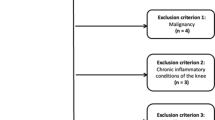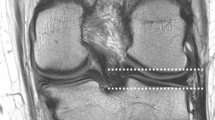Abstract
Objective
To examine dual-energy computed tomography (DECT) in evaluating cruciate ligament injuries. More specifically, the purpose was to assess the optimal keV level in DECT gemstone spectral imaging (GSI) images and to examine the usefulness of collagen-specific color mapping and dual-energy bone removal in the evaluation of cruciate ligaments and the popliteus tendon.
Materials and methods
At a level 1 trauma center, a 29-month period of emergency department DECT examinations for acute knee trauma was reviewed by two radiologists for presence of cruciate ligament injuries, visualization of the popliteus tendon and the optimal keV level in GSI images. Three different evaluating protocols (GSI, bone removal and collagen-specific color mapping) were rated. Subsequent MRI served as a reference standard for intraarticular injuries.
Results
A total of 18 patients who had an acute knee trauma, DECT and MRI were found. On MRI, six patients had an ACL rupture. DECT’s sensitivity and specificity to detect ACL rupture were 79 % and 100 %, respectively. The DECT vs. MRI intra- and interobserver proportions of agreement for ACL rupture were excellent or good (kappa values 0.72–0.87). Only one patient had a PCL rupture. In GSI images, the optimal keV level was 63 keV. GSI of 40–140 keV was considered to be the best evaluation protocol in the majority of cases.
Conclusion
DECT is a usable method to evaluate ACL in acute knee trauma patients with rather good sensitivity and high specificity. GSI is generally a better evaluation protocol than bone removal or collagen-specific color mapping in the evaluation of cruciate ligaments and popliteus tendon.


Similar content being viewed by others
References
Hash 2nd TW. Magnetic resonance imaging of the knee. Sports Health. 2013;5:78–107.
Mustonen AO, Koivikko MP, Haapamaki VV, Kiuru MJ, Lamminen AE, Koskinen SK. Multidetector computed tomography in acute knee injuries: assessment of cruciate ligaments with magnetic resonance imaging correlation. Acta Radiol. 2007;48:104–11.
Deng K, Li W, Wang JJ, Wang GL, Shi H, Zhang CQ. The pilot study of dual-energy CT gemstone spectral imaging on the image quality of hand tendons. Clin Imaging. 2013;37:930–3.
Johnson TR, Krauss B, Sedlmair M, et al. Material differentiation by dual energy CT: initial experience. Eur Radiol. 2007;17:1510–7.
Fickert S, Niks M, Dinter DJ, et al. Assessment of the diagnostic value of dual-energy CT and MRI in the detection of iatrogenically induced injuries of anterior cruciate ligament in a porcine model. Skelet Radiol. 2013;42:411–7.
Glazebrook KN, Brewerton LJ, Leng S, et al. Case–control study to estimate the performance of dual-energy computed tomography for anterior cruciate ligament tears in patients with history of knee trauma. Skelet Radiol. 2014;43:297–305.
Sun C, Miao F, Wang XM, et al. An initial qualitative study of dual-energy CT in the knee ligaments. Surg Radiol Anat. 2008;30:443–7.
Saltybaeva N, Jafari ME, Hupfer M, Kalender WA. Estimates of effective dose for CT scans of the lower extremities. Radiology. 2014;273:153–9.
Landis JR, Koch GG. The measurement of observer agreement for categorical data. Biometrics. 1977;33:159–74.
Klass D, Toms AP, Greenwood R, Hopgood P. MR imaging of acute anterior cruciate ligament injuries. Knee. 2007;14:339–47.
Moore SL. Imaging the anterior cruciate ligament. Orthop Clin N Am. 2002;33:663–74.
Noyes FR, Bassett RW, Grood ES, Butler DL. Arthroscopy in acute traumatic hemarthrosis of the knee. Incidence of anterior cruciate tears and other injuries. J Bone Joint Surg Am. 1980;62:687–95.
Van Dyck P, De Smet E, Veryser J, et al. Partial tear of the anterior cruciate ligament of the knee: injury patterns on MR imaging. Knee Surg Sports Traumatol Arthrosc. 2012;20:256–61.
LaPrade RF, Wentorf FA, Fritts H, Gundry C, Hightower CD. A prospective magnetic resonance imaging study of the incidence of posterolateral and multiple ligament injuries in acute knee injuries presenting with a hemarthrosis. Arthroscopy. 2007;23:1341–7.
Biswas D, Bible JE, Bohan M, Simpson AK, Whang PG, Grauer JN. Radiation exposure from musculoskeletal computerized tomographic scans. J Bone Joint Surg Am. 2009;91:1882–9.
Author information
Authors and Affiliations
Corresponding author
Rights and permissions
About this article
Cite this article
Peltola, E.K., Koskinen, S.K. Dual-energy computed tomography of cruciate ligament injuries in acute knee trauma. Skeletal Radiol 44, 1295–1301 (2015). https://doi.org/10.1007/s00256-015-2173-x
Received:
Revised:
Accepted:
Published:
Issue Date:
DOI: https://doi.org/10.1007/s00256-015-2173-x




